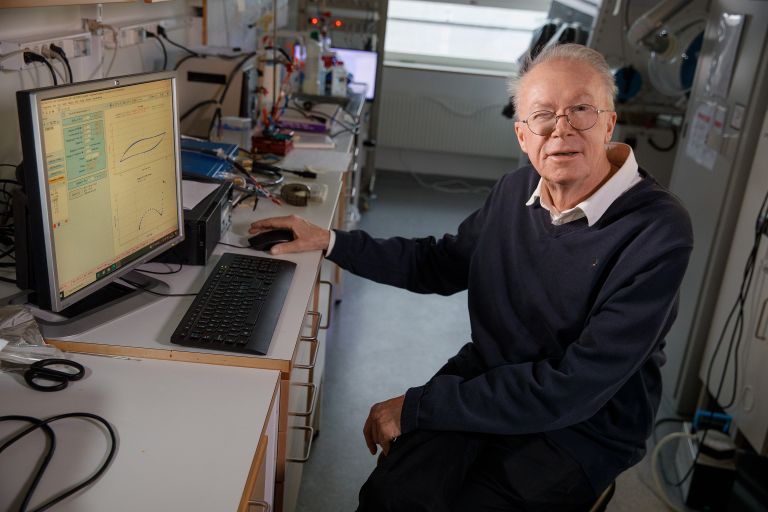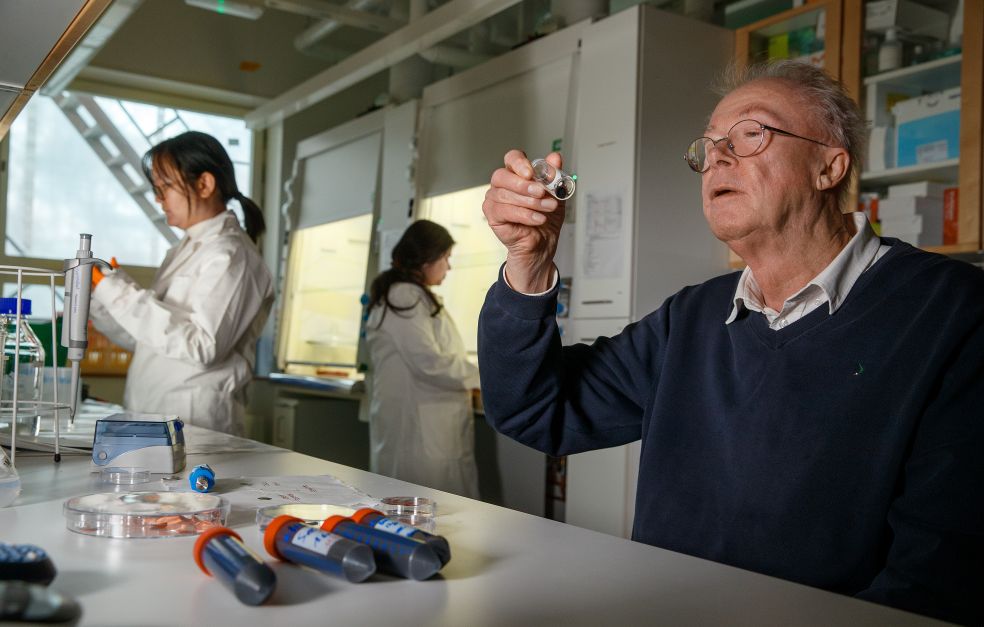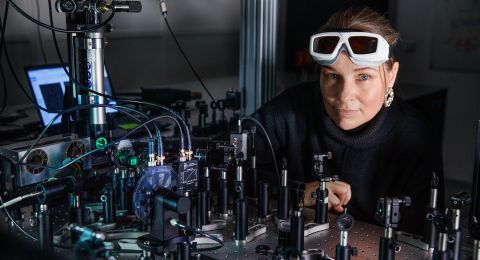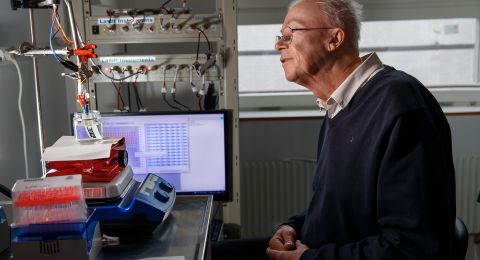Wallenberg Scholar Olle Inganäs is developing materials for the batteries of the future, based on raw materials from forests and oceans and readily available metals. The goal is the stationary storage of energy on a large scale at wind farms or solar power plants, for example, using rechargeable batteries that are safe, cost-effective and environmentally sustainable.
Olle Inganäs
Professor Emeritus of Biomolecular and Organic Electronics
Wallenberg Scholar
Institution:
Linköping University
Research field:
Energy conversion at the interface between electronics and biological systems
“This gelatinous material is what it’s all about,” says Inganäs, holding up a test tube containing a transparent paste.
He is professor emeritus in biomolecular and organic electronics at Linköping University. His research career has yielded innovations such as wood-based batteries and paper-thin organic solar cells. Now he is taking on the challenge of large-scale energy storage.
We are now able to produce more and more of our electricity from renewable sources such as solar and wind power. However, to fully utilize this, we need to be able to store energy for later use. Solar energy, for instance, must be stored from day to night, and electricity from wind turbines must be stored on windy days for use on calm ones.
Zinc batteries pose a challenge
Rechargeable lithium-ion batteries are a common way to store energy and are used in everything from electronics to electric cars. They come with certain drawbacks, however. They can ignite explosively, often contain cobalt extracted under poor labor conditions, and their metal recycling is complex. This has led to an intensive search for better solutions.
“For large-scale battery storage, it would be beneficial to have something safer. And we need to use materials that are inexpensive, abundant and have a lower environmental impact than those we have used so far,” says Inganäs.
In this project, he is using zinc as the battery’s anode. Zinc is more common than lithium, is mined in Sweden and is easier to recycle. In zinc batteries, the electrolyte – the material between the battery’s poles – can also be water-based and therefore non-flammable.
Developing rechargeable zinc batteries with a water-based electrolyte is a challenge, however. Flammable hydrogen gas can form during discharge, and zinc deposits risk short-circuiting the battery.
Shrimp shells and algae
Inganäs has developed an electrolyte that appears to solve these problems. He drew inspiration from the spiral-shaped protein structures that allow ions to pass in and out of human cells. The electrolyte is produced by combining two naturally occurring polymers: alginate and chitin.
Alginate is found in marine algae. Chitosan is derived from chitin extracted from crustacean shells.
This gel-like electrolyte has shown promising results, as Inganäs explains:
“It withstood 7,000 cycles without short-circuiting, which is significant for this type of process. We achieve selective zinc-ion transport and sufficient conductivity.”
A battery also requires a cathode. Inganäs has previously demonstrated that lignin, a byproduct in the pulp and paper industry, could be used to manufacture cathodes. Although these cathodes performed well (with results published in Science in 2012), they suffered from self-discharge issues.
We need better batteries to fully exploit the potential of electricity from solar and wind power.
This time, he wants to harness the excellent conductivity of charcoal – wood that has been pyrolyzed (heated in an oxygen-poor environment).
“Alessandro Volta, the father of the battery, knew as far back as the late 18th century that charcoal conducts electricity,” says Inganäs, whose interest in the history of science becomes evident throughout our conversation.
He has demonstrated that electrodes made of charcoal perform at least as well as the more complex lignin electrodes and is now examining how charcoal can be used as a raw material for electrodes.
“This is exciting to see. These are the first measurements we have made of these materials. The charcoal comes from spruce forest waste from northern Sweden that has been pyrolyzed in combination with a zinc salt,” he says as we enter a lab in the Department of Fiber and Polymer Technology at KTH Royal Institute of Technology.
The research is being conducted at KTH because Inganäs has chosen existing environments used by people he has worked with before, instead of resuming activities at his own laboratory in Linköping. Researchers at Chalmers University of Technology in Gothenburg are studying ion transport in the electrolytes. A team at Linköping University is characterizing electrolytes and carbon-based electrodes. Here at KTH, the researchers are assembling the materials in battery cells and performing electrochemical measurements.
Hat trick
This is the third time Inganäs has received a Wallenberg Scholar grant. This time he aims to complete his research in three years instead of five.
“By then, I want to have doubled the energy storage capacity compared with when I started with a piece of charcoal, and develop stable electrolytes that can withstand temperatures from -20 to +60 degrees Celsius, enabling them to be used as stationary batteries.”
The results will remain at laboratory scale, but he is already considering large-scale production methods. He envisions battery containers stationed at wind farms or solar power plants, functioning as charging stations or power sources at harbors where rapid pulses of electricity are needed for heavy lifting.
“There are many niches for the kind of battery we want to achieve: a battery that is non-flammable, made from inexpensive materials and has a low environmental impact,” says Inganäs.
Text Sara Nilsson
Translation Maxwell Arding
Photo Magnus Bergström






